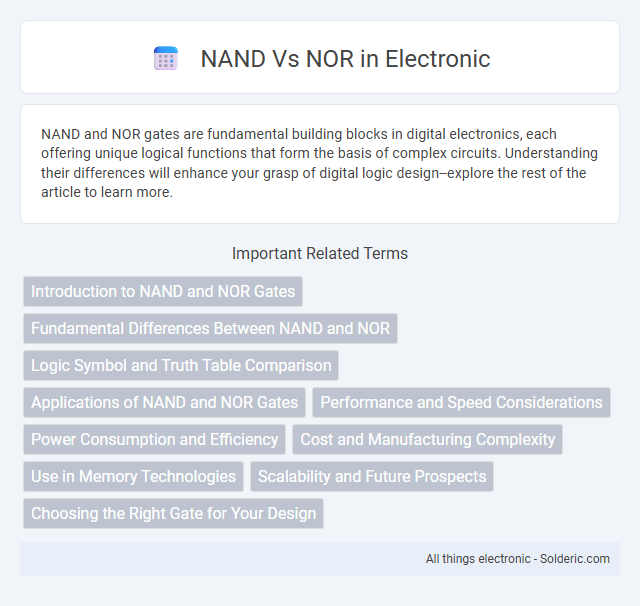NAND and NOR gates are fundamental building blocks in digital electronics, each offering unique logical functions that form the basis of complex circuits. Understanding their differences will enhance your grasp of digital logic design--explore the rest of the article to learn more.
Comparison Table
| Feature | NAND Gate | NOR Gate |
|---|---|---|
| Definition | Output is false only when all inputs are true (NOT AND) | Output is true only when all inputs are false (NOT OR) |
| Symbol | AND gate followed by NOT gate | OR gate followed by NOT gate |
| Boolean Expression | Y = (A * B)' | Y = (A + B)' |
| Truth Table Summary | All inputs true - Output 0; otherwise 1 | All inputs false - Output 1; otherwise 0 |
| Functional Use | Universal gate; used for NAND memory and logic circuits | Universal gate; used in NOR memory and logic circuits |
| Common Applications | Flip-flops, multiplexers, basic digital circuits | Oscillators, inverters, logic combinations |
| Logical Operation | Inverse of AND | Inverse of OR |
Introduction to NAND and NOR Gates
NAND and NOR gates are fundamental building blocks in digital electronics, functioning as universal gates capable of implementing any Boolean function. A NAND gate outputs a low signal only when all its inputs are high, while a NOR gate produces a high output only when all inputs are low. Understanding the behavior of these gates helps you design efficient logical circuits and optimize digital systems for performance and reliability.
Fundamental Differences Between NAND and NOR
NAND and NOR gates differ fundamentally in their logic operations: a NAND gate outputs a low signal only when all inputs are high, while a NOR gate outputs a high signal only when all inputs are low. NAND gates are generally preferred for implementing universal logic functions due to their faster switching speeds and lower power consumption compared to NOR gates. Understanding these differences helps you select the appropriate gate type for optimizing digital circuit performance.
Logic Symbol and Truth Table Comparison
NAND and NOR gates feature distinct logic symbols: the NAND gate symbol combines an AND gate with a small circle (inversion bubble) at the output, while the NOR gate symbol combines an OR gate with the inversion bubble. The NAND gate outputs a logical 0 only when all inputs are 1, as reflected in its truth table, whereas the NOR gate outputs a logical 1 only when all inputs are 0, demonstrating the fundamental difference in their behavior. Analyzing both truth tables highlights that NAND performs the negation of an AND operation and NOR performs the negation of an OR operation, essential for digital circuit design.
Applications of NAND and NOR Gates
NAND gates are extensively used in digital circuits for implementing universal logic functions, memory storage elements like flip-flops, and microprocessor combinational logic, leveraging their versatility in creating any logical operation. NOR gates find applications in control circuits, priority encoders, and simple logic implementations within digital systems due to their inherent simplicity and functional completeness. Both gates serve as fundamental building blocks in programmable logic devices and integrated circuit design, optimizing processing efficiency and circuit complexity.
Performance and Speed Considerations
NAND gates typically offer faster switching speeds and lower propagation delays compared to NOR gates due to their simpler transistor arrangement and reduced capacitance. NAND logic circuits consume less power during high-speed operations, making them preferable in performance-critical applications like CPU design. NOR gates, while slower, provide better noise immunity and are used where speed is less critical but stability and signal integrity are prioritized.
Power Consumption and Efficiency
NAND gates generally consume less power than NOR gates due to their transistor arrangement, making them more efficient for integrated circuit design. In CMOS technology, NAND gates have fewer transistors switching simultaneously, reducing dynamic power consumption significantly. Choosing NAND gates can optimize Your circuit's energy efficiency while maintaining reliable performance in digital applications.
Cost and Manufacturing Complexity
NAND gates generally have lower manufacturing costs and simpler fabrication processes compared to NOR gates due to their fewer transistors and efficient layout in CMOS technology. Your choice favors NAND for cost-effective designs in memory and logic circuits, as they offer higher density and lower power consumption. NOR gates, although more complex and expensive, are often used where simpler logic functions and faster switching are required despite higher manufacturing complexity.
Use in Memory Technologies
NAND and NOR gates are fundamental in memory technologies, with NAND flash memory widely used for high-density storage devices like SSDs and USB drives due to its faster write and erase operations and better scalability. NOR flash memory excels in fast read speeds and random access, making it ideal for code storage in embedded systems and firmware applications. Understanding your memory requirements helps determine whether NAND's efficiency or NOR's speed is the best fit for your technology solution.
Scalability and Future Prospects
NAND flash memory offers superior scalability compared to NOR due to its denser architecture and smaller cell size, enabling higher storage capacities and cost efficiency. NOR flash, while providing faster read speeds and random access, faces limitations in scaling down beyond current technology nodes, impacting its future viability for high-density storage solutions. Your choice between NAND and NOR should consider NAND's dominance in scalable storage applications like SSDs, while NOR remains relevant for firmware and code storage with future advancements focused on enhancing NAND's endurance and speed.
Choosing the Right Gate for Your Design
Selecting the right logic gate for your design hinges on performance requirements, power consumption, and circuit complexity. NAND gates offer faster switching speeds and lower power usage, making them ideal for high-speed applications and large-scale integration. In contrast, NOR gates provide simpler logic structures and are preferable when implementing NOR-based logic functions or specific memory elements like NOR flash.
NAND vs NOR Infographic

 solderic.com
solderic.com